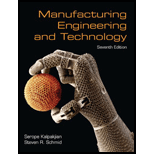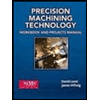
Manufacturing Engineering & Technology
7th Edition
ISBN: 9780133128741
Author: Serope Kalpakjian, Steven Schmid
Publisher: Prentice Hall
expand_more
expand_more
format_list_bulleted
Textbook Question
Chapter 26, Problem 2RQ
How is the size of an abrasive grain related to its number?
Expert Solution & Answer
Want to see the full answer?
Check out a sample textbook solution
Students have asked these similar questions
8. A note in the comment section of a title block mentions that all faces should have
a +.10 tolerance before heat treatment. The machinist follows the instructions but for
diameters he leaves a tolerance of +.20. Why?
O A. The machinist may have committed an error, and the part must be returned prior to
heat treatment.
OB. Diameter dimensions usually change by twice as much as the faces.
OC. The tolerances for diameters aren't as critical as face tolerances.
D. It's easier for the machinist to adopt MMC for diameters.
Grit of a grinding wheel is defined as the
The size of the abrasive grains in the wheel
The grade indicates the strength of the bond in the wheel
The density of the grains in wheel
A material that holds the abrasive grains together to form a grinding wheel
Grade of a grinding wheel is defined as the
The density of the grains in wheel
A material that holds the abrasive grains together to form a grinding wheel
Indicates the strength of the bond in the wheel
The size of the abrasive grains in the wheel
Chapter 26 Solutions
Manufacturing Engineering & Technology
Ch. 26 - What is an abrasive? What are superabrasives?Ch. 26 - How is the size of an abrasive grain related to...Ch. 26 - Why are most abrasives made synthetically?Ch. 26 - Describe the structure of a grinding wheel and its...Ch. 26 - Explain the characteristics of each type of bond...Ch. 26 - What causes grinding sparks in grinding? Is it...Ch. 26 - Define metallurgical burn.Ch. 26 - Define (a) friability, (b) wear flat, (c) grinding...Ch. 26 - What is creep-feed grinding and what are its...Ch. 26 - How is centerless grinding different from...
Ch. 26 - What are the differences between coated and bonded...Ch. 26 - What is the purpose of the slurry in...Ch. 26 - Explain why grinding operations may be necessary...Ch. 26 - Why is there such a wide variety of types, shapes,...Ch. 26 - Prob. 15QLPCh. 26 - The grinding ratio, G, depends on the type of...Ch. 26 - What are the consequences of allowing the...Ch. 26 - Explain why speeds are much higher in grinding...Ch. 26 - Prob. 19QLPCh. 26 - Prob. 20QLPCh. 26 - Prob. 21QLPCh. 26 - Referring to the preceding chapters on processing...Ch. 26 - Explain the reasons that so many deburring...Ch. 26 - What precautions should you take when grinding...Ch. 26 - Prob. 25QLPCh. 26 - What factors could contribute to chatter in...Ch. 26 - Prob. 27QLPCh. 26 - Prob. 28QLPCh. 26 - Describe the effects of a wear flat on the overall...Ch. 26 - What difficulties, if any, could you encounter in...Ch. 26 - Prob. 31QLPCh. 26 - Prob. 32QLPCh. 26 - Prob. 33QLPCh. 26 - Jewelry applications require the grinding of...Ch. 26 - List and explain factors that contribute to poor...Ch. 26 - Calculate the chip dimensions in surface grinding...Ch. 26 - If the strength of the workpiece material is...Ch. 26 - Assume that a surface-grinding operation is being...Ch. 26 - Estimate the percent increase in the cost of the...Ch. 26 - Assume that the energy cost for grinding an...Ch. 26 - It is known that, in grinding, heat checking...Ch. 26 - Prob. 45QTPCh. 26 - With appropriate sketches, describe the principles...Ch. 26 - Prob. 47SDPCh. 26 - Vitrified grinding wheels (also called ceramic...Ch. 26 - Conduct a literature search, and explain how...Ch. 26 - Visit a large hardware store and inspect the...Ch. 26 - Obtain a small grinding wheel or a piece of a...Ch. 26 - In reviewing the abrasive machining processes in...Ch. 26 - Obtain pieces of sandpaper and emery cloth of...Ch. 26 - On the basis of the contents of this chapter,...
Knowledge Booster
Learn more about
Need a deep-dive on the concept behind this application? Look no further. Learn more about this topic, mechanical-engineering and related others by exploring similar questions and additional content below.Similar questions
- 1)Meaning of the term "Grade" in a grinding wheel is a. How much spacing between the abrasive grains in the grinding wheel b. The ability of the abrasive grains to hold together to form the grinding wheel c. The strength of the bond inside the grinding wheel d. The abrasive grain size used in grinding wheel production 2)In a Vernier Caliper if the vernier scale with ______________divisions (lines), will be 0.05 mm least count. a. 50 b. 30 c. 20 d. 40arrow_forwardWhat abrasive is commonly used to grind steels?arrow_forwardThe bond of a grinding wheel is defined as A material that holds the abrasive grains together to form a grinding wheel The density of the grains in wheel The size of the abrasive grains in the wheel Indicates the strength of the bond in the wheelarrow_forward
- -How many holes require drilling? -What is the center to center distance of the 6mm tapped holes? -What tap drill is used for holes marked Z? -How many surfaces are machine finished? -What are the dimensions of the face marked F & C? -What are the dimensions have symbols A, E &, B -In what dihedral angle is the drawing made? -What is the max and min dimensions of D -What is the tolerance of measurement D?arrow_forwardbreak these down and identify necessary information, such as what the question is asking you to find, solve. Fixing a wheel barrow takes a specific diameter axel of 2.50 inches. Thankfully, the manufactureprovided an allowable tolerance of at most 0.05 inches. While looking at the hardware store,what are the range of rods you will pick from?arrow_forwardThe structure of a grinding wheel is defined as A material that holds the abrasive grains together to form a grinding wheel The density of the grains in wheel Indicates the strength of the bond in the wheel The size of the abrasive grains in the wheelarrow_forward
- Abrasive machining makes use of ______ to remove material.arrow_forwardThe structure of a grinding wheel is defined as 1-A material that holds the abrasive grains together to form a grinding wheel 2-The density of the grains in wheel 3-Indicates the strength of the bond in the wheel 4-The size of the abrasive grains in the wheelarrow_forward"The tolerance is in the 3rd significant digit" Pls answer correctly. Thank you!arrow_forward
arrow_back_ios
SEE MORE QUESTIONS
arrow_forward_ios
Recommended textbooks for you
 Welding: Principles and Applications (MindTap Cou...Mechanical EngineeringISBN:9781305494695Author:Larry JeffusPublisher:Cengage Learning
Welding: Principles and Applications (MindTap Cou...Mechanical EngineeringISBN:9781305494695Author:Larry JeffusPublisher:Cengage Learning Precision Machining Technology (MindTap Course Li...Mechanical EngineeringISBN:9781285444543Author:Peter J. Hoffman, Eric S. Hopewell, Brian JanesPublisher:Cengage Learning
Precision Machining Technology (MindTap Course Li...Mechanical EngineeringISBN:9781285444543Author:Peter J. Hoffman, Eric S. Hopewell, Brian JanesPublisher:Cengage Learning

Welding: Principles and Applications (MindTap Cou...
Mechanical Engineering
ISBN:9781305494695
Author:Larry Jeffus
Publisher:Cengage Learning

Precision Machining Technology (MindTap Course Li...
Mechanical Engineering
ISBN:9781285444543
Author:Peter J. Hoffman, Eric S. Hopewell, Brian Janes
Publisher:Cengage Learning
Introduction to Ferrous and Non-Ferrous Metals.; Author: Vincent Ryan;https://www.youtube.com/watch?v=zwnblxXyERE;License: Standard Youtube License